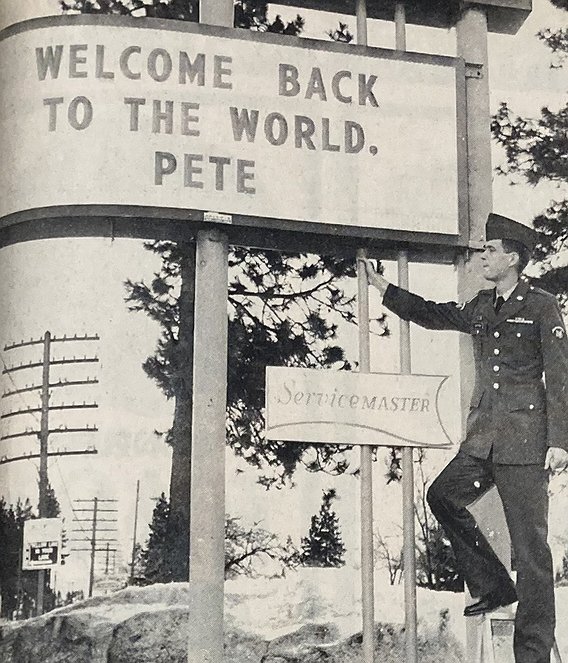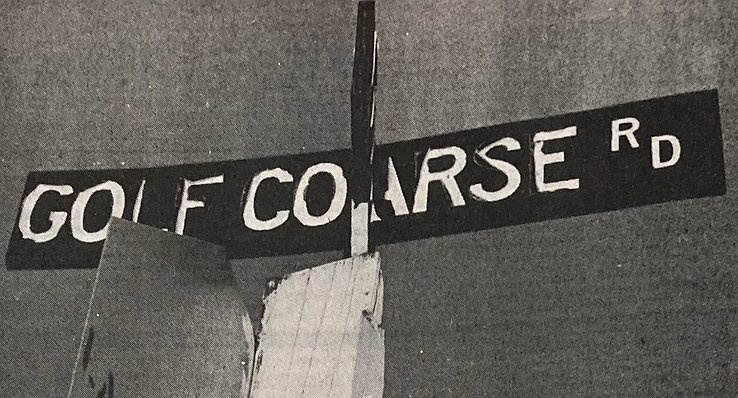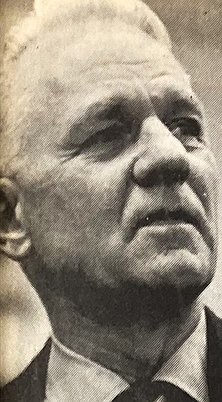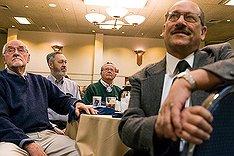Huckleberries: Seattle's all wet; water skiing was invented in Cd'A

Father Jack Finney, left, and four of his children — Mary, John, Harriett and Walter — display their wakeboard and water skis in about 1931.
Photo courtesy of Museum of North Idaho

Jack Finney performs a water stunt with daughters Harriett and Mary.

SP5 Pete Shepperd was welcomed back to Coeur d’Alene after a year in Vietnam.

Mannie Schneidmiller stands in the door of his leaning Post Falls barn.

Coeur d’Alene firefighters save the future home of the Museum of North Idaho.

The original Golf Course Road sign in Coeur d’Alene had a slight, but amusing, error.

Streaking was popular on college campuses in 1974. But that doesn’t mean that this gag sign at North Idaho College attracted anyone.

Howard Hudson.

Former Cd'A mayors, from left, Don Johnston, Al Hassell, John McHugh and Jim Fromm listen to then-mayor Steve Widmyer speak.
The American Water Ski Association contends that 18-year-old Minnesotan Ralph Samuelson invented water skiing July 1, 1922.
Or about the same time that the Finney family took up water skiing on Lake Coeur d’Alene.
One thing’s certain: Water skiing in the Pacific Northwest began in Coeur d'Alene and not Seattle.
In March 1959, Herb Robinson and George Evjen, both of Seattle, traveled here to prove that water skiing in the Northwest began in Coeur d’Alene. This was after Seattle newspapers insisted that the sport started in 1929 on Lake Washington.
But Robinson said that he’d seen Clyde Stricker, then of Coeur d’Alene, skiing in 1923 at the Rose Show in Portland.
Old issues of The Press backed up his claim that water skiing had arrived at Coeur d'Alene before Seattle.
Robinson and Evjen found stories about Coeur d’Alene Fourth of July celebrations, listing water skiing performances before 1929. On July 6, 1925, The Press reported: “Frayne Gaylord was awarded the cup for water ski riding.”
Stricker had started skiing before Gaylord, in 1922.
Then, the two Washingtonians found that John Finney used 4-inch flooring to try water skiing here in 1921 or 1922. And that he and his brother, Walt, successfully skied afterward. John E. “Jack” Finney is credited with starting son John in the sport.
In a 1997 story about the aquatic Finney family, The Spokesman-Review reported that John Finney had begun skiing on floorboards with a pair of laced-up shoes screwed to them. The ends were soaked in boiling water to make them curl for a smoother ride.
A sister, Harriett, said John began skiing in 1921, a year before Minnesotan Samuelson.
In 1925 or 1926, Jack Finney and four of his children, including John, were invited to perform on surfboards and water skis at the World Swim Meet on Green Lake, near Seattle. The featured attraction was Johnny Weissmuller, an Olympic gold medalist who played Tarzan in 12 movies.
In 1932, John — better known later as Captain John Finney — began a pleasure cruise business by leasing and later buying the 65-foot, 265-passenger Seeweewana. A half-century later, he retired and sold his successful and expanded business to Hagadone Hospitality.
Bill Finney, one of Captain John’s youngest siblings, explained to The Spokesman-Review why his brother didn’t push a claim to be the inventor of water skiing: “My brother had the opportunity to prove that he was the first one. But he didn’t seem to care.”
A vet returns
Some in this country didn't welcome soldiers like Pete Shepperd back from Vietnam.
But Pete's hometown did.
Pete, the bass player in the popular local 1960s band, The Shadows, missed the turmoil in this country while serving in the Army in South Vietnam for a year beginning in March 1968. Upon his return, a disgusting gesture by a stranger in the San Francisco Airport taught him how divisive the Vietnam War was on the home front.
Decked out in a new uniform, Pete was waiting for a plane home when a man approached and spit on him. “I wasn’t ready for that,” Pete, a retired business education instructor, told Huckleberries.
His return to Coeur d’Alene, however, was treated 180 degrees differently.
Messages on several sign boards heralded his safe return, including one from Smitty’s Carpets that read: “Welcome Back to the World, Pete.” Owners of the old Rathskellers tavern told Pete that his favorite stool was waiting for him.
High school graduation and then Vietnam ruptured The Shadows, three of whom, besides Pete, served during wartime: Doug Wanamaker, Dexter Yates and Jim Frame.
The band reunited in the 1980s, under the name The Fabulous Shadows, to play for a fundraiser and then delighted fans by performing regular reunion gigs for decades.
All fall down
Grass growing has come and gone from the Rathdrum Prairie, but Mannie Schneidmiller remains the godfather of the halcyon days of the important industry.
So why was the visionary farmer and his brother, Elmer, wishin’/hopin’/prayin’ in March 1959 that their hay barn would fall down? Well, for one thing, the barn was leaning to the north — and had done so more and more each day for six months.
The leaning barn became a curiosity for passing motorists.
A few years before, the brothers had bought the 300-acre former dairy, with the 90-by-30 barn, at McGuire Road and Highway 10 (Seltice Way) in Post Falls, from Guy Boston, who still occupied the place. Boston tried to steady the barn by using cables. But that approach failed.
Then, the brothers pulled the supports and hoped that it would fall. Mannie told The Press: “Perhaps a good wind will come along and save us the job of razing it.”
Who knows? Maybe nature took its course.
Huckleberries
• Poet’s Corner: April is the month for fibbing,/spinning tall tales and ad-libbing,/with fervent hope they don’t distress/those folks down at the IRS — The Bard of Sherman Avenue (“April”).
• Quick Response: If you love/love/love the emerging new home of the Museum of North Idaho at the base of Tubbs Hill, thank a Cd'A firefighter. Fifty-five years ago (March 29, 1969), a quick response from CFD contained a roof fire started by chimney sparks in the historic J.C. White House at Eighth and Sherman. So it was still standing to be claimed by the museum and moved Nov. 16, 2019. And to become a source of town pride for years to come.
• Of Coarse: A golf course is not coarse, of course. So you can imagine the fun a Coeur d’Alene Press photographer had 45 years ago (March 27, 1979) when a caller reported that the city had goofed in erecting the street sign for “GOLF COARSE RD,” which now runs along the south side of the Kroc Center. Perhaps the snafu resulted in a coarse word or two.
• Streaker Stop: In 1974, when streaking was at its peak on college campuses, a wishful thinker at North Idaho College took note — and added a few words to a construction sign heralding a new science building: “Female Streakers Rest Area Ahead.” The sign hadn’t attracted any takers, The Press said. But it was March, and the weather was improving.
• Howard Hudson RIP: Fifty years ago (March 29, 1974), Cd'A reeled from the loss of Howard Hudson, the second in a family line to own what is now the Hudson’s Hamburgers dynasty. The former councilman and civic leader died a month after suffering a heart attack, prompting Vern Hippler, another former council member, to say: “I’m so stunned I can hardly think straight.”
• Bargain Price: For those keeping score at home, then-mayor Don Johnston cut the ribbon on the now-not-so-new Cd'A City Hall on March 20, 1979. Construction cost: $1.13 million.
Parting shot
On March 22, 2014, new mayor Steve Widmyer invited eight former mayors, dating back to 1970, to hear him describe leadership to Coeur d’Alene Rotarians. He figured — correctly — that the six who showed up, along with Ray Stone’s widow, Betty, exemplified leadership. Each had left a mark on our remarkable city: John McHugh (1969-73), Ron Edinger (1973-77), Don Johnston (1977-81), Jim Fromm (1981-85), Ray Stone (1985-93), Al Hassell (1993-97), Steve Judy (1997-2001), and Sandi Bloem (2001-14). Widmyer served with distinction from 2014-22. And Jim Hammond, Coeur d’Alene’s 35th mayor, has served well since. Many quality mayors have run this town in the last 54 years, including the transformational ones of the 21st century. We shouldn’t take top-notch leadership for granted as we see quality nonpartisan institutions, like North Idaho College and Community Library Network, compromised by blind faith in extreme ideology.
D.F. (Dave) Oliveria can be contacted at dfo@cdapress.com.








